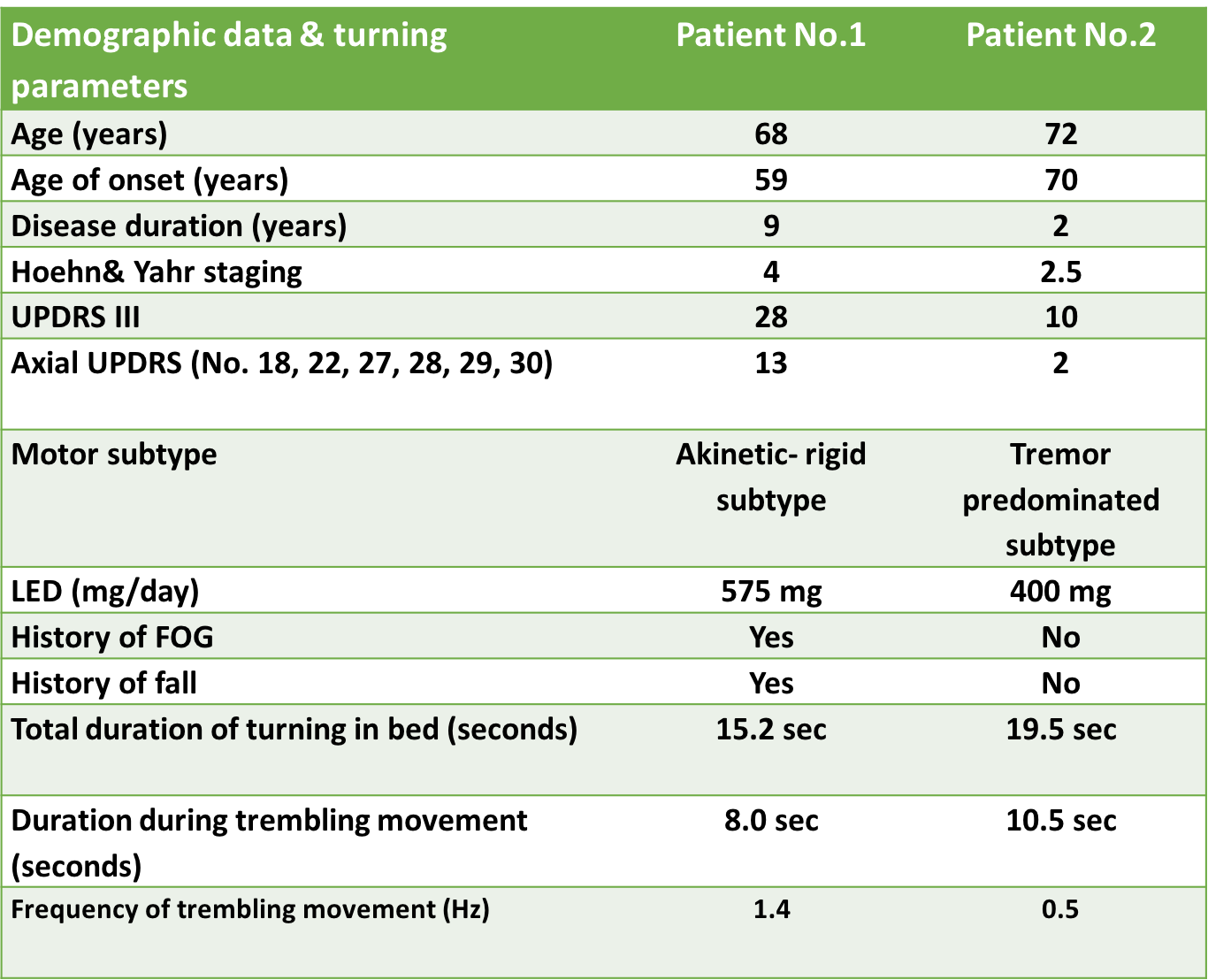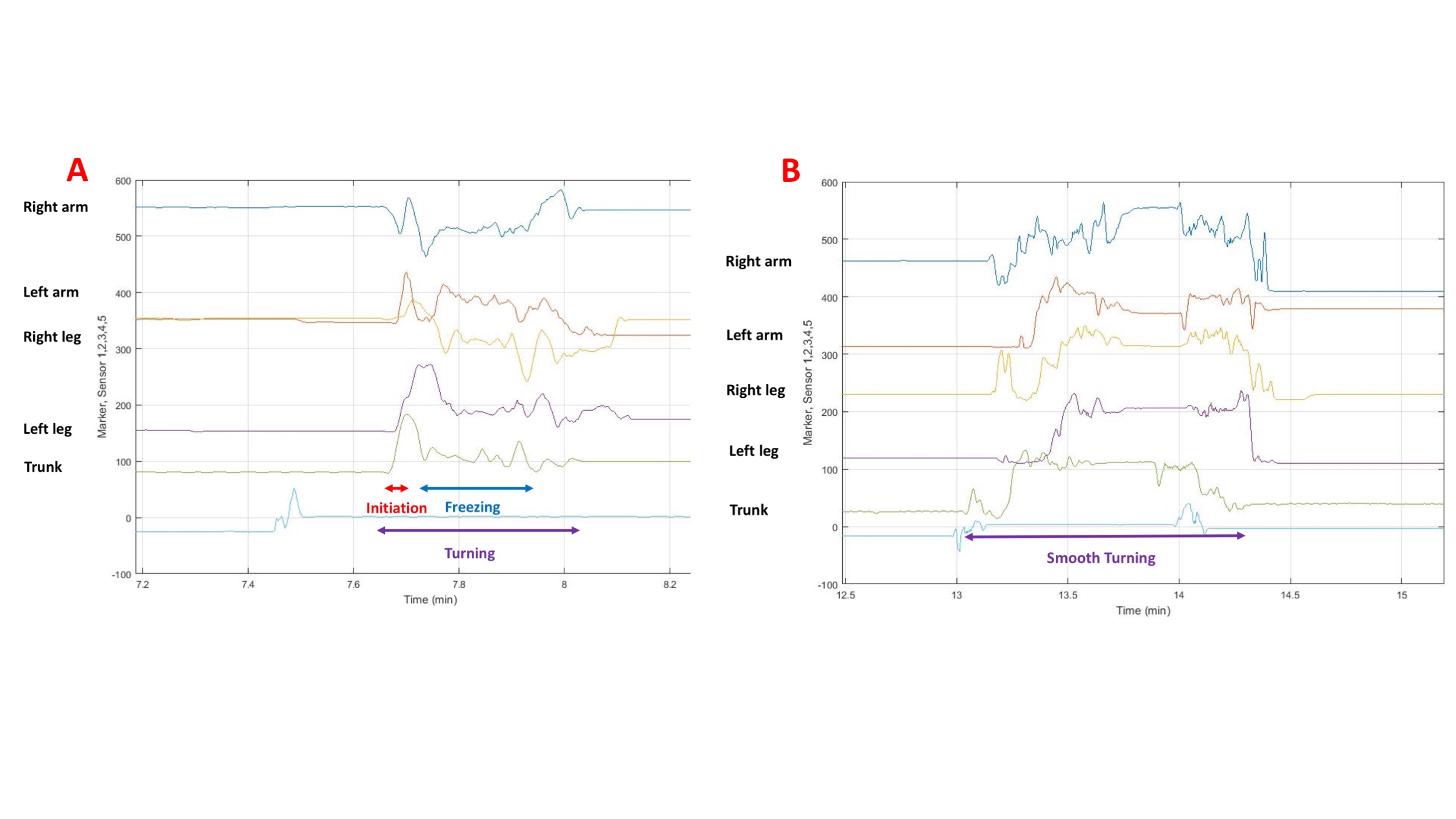Objective: To identify characteristics of freezing of turning in bed in PD patients using an axial inertial sensor (NIGHT-Recorder®) and synchronous video recording.
Background: Freezing refers to transient episodes, usually lasting seconds, in which a continuous motor activity attempted by an individual is halted or markedly reduced. It most frequently affects gait (freezing of gait, FOG) and speech with other continuous movements, less affected. A clinical hallmark of FOG is “trembling of knees or legs”, characterised as an alternating shaking of the knees or legs, which is also common during turning movements. Turning in bed during the night is a continuous movement and difficulty undertaking this movement is a recognised symptom of PD, considered to be a spectrum of nocturnal hypokinesia.
Method: The ability of 16 PD patients with a history of nocturnal hypokinesia [table 1] to turn in bed laterally from right to left were assessed. A NIGHT-Recorder® was attached according to previously published protocol. Turning parameters were analysed.
Results: 14 of the 16 patients could completely turn in bed by themselves. Mean duration of turning was 18.5 + 20.0 seconds, velocity of turning was 12.8 + 11.0 degree/sec, and torque was 0.22 + 0.15 T/kg. Five patients performed the turning task with a slow, but the continuous movement. Seven patients performed the turning task in one or two steps, using upper or lower limbs to push their body around. However, two patients had distinct turning in bed characteristics. Both of them could initiate the turn, but in the middle of the turn their movements suddenly paused and they tried to continue the turn with repetitive backward and forward movement similar to the trembling of legs seen with FOG. This ‘tremble’ lasted for 8 (1.4 Hz) and 10.5 (0.5 Hz) seconds respectively after which that they could complete the turning in bed task [table 2]. Figure 2 shows sensor signals of PD patients with freezing in bed turning and completely turn [figure2]
Conclusion: Our findings showed a distinct feature of turning in bed similar to the trembling of legs or knees seen in FOG. One of the possible pathological mechanisms for freezing of turning in bed is an impaired attention control by the basal ganglia in conjunction with the supplementary motor area (SMA) suggesting a common pathway with FOG. We proposed a new characteristic of nocturnal hypokinesia called ‘freezing of turning in bed’.
References: 1. Sringean J, Anan C, Bhidayasiri R. Impaired ability to turn in bed in Parkinson’s disease as a potential rare cause of positional asphyxia: a sensor-based analysis. Clin Neurol Neurosurg. 2020;192:105713. 2. Bhidayasiri R, Sringean J, Thanawattano C. Impaired bed mobility: quantitative torque analysis with axial inertial sensors. Neurodegener Dis Manag. 2017;7:235-43. 3. Iansek R, Danoudis M. Freezing of Gait in Parkinson’s Disease: Its Pathophysiology and Pragmatic Approaches to Management. Mov Disord Clin Pract. 2017;4:290-7.
To cite this abstract in AMA style:
J. Sringean, C. Anan, C. Thanawattano, R. Bhidayasiri. A sensor-based analysis of freezing of turning in bed: A new manifestation of nocturnal hypokinesia [abstract]. Mov Disord. 2020; 35 (suppl 1). https://www.mdsabstracts.org/abstract/a-sensor-based-analysis-of-freezing-of-turning-in-bed-a-new-manifestation-of-nocturnal-hypokinesia/. Accessed April 2, 2025.« Back to MDS Virtual Congress 2020
MDS Abstracts - https://www.mdsabstracts.org/abstract/a-sensor-based-analysis-of-freezing-of-turning-in-bed-a-new-manifestation-of-nocturnal-hypokinesia/



